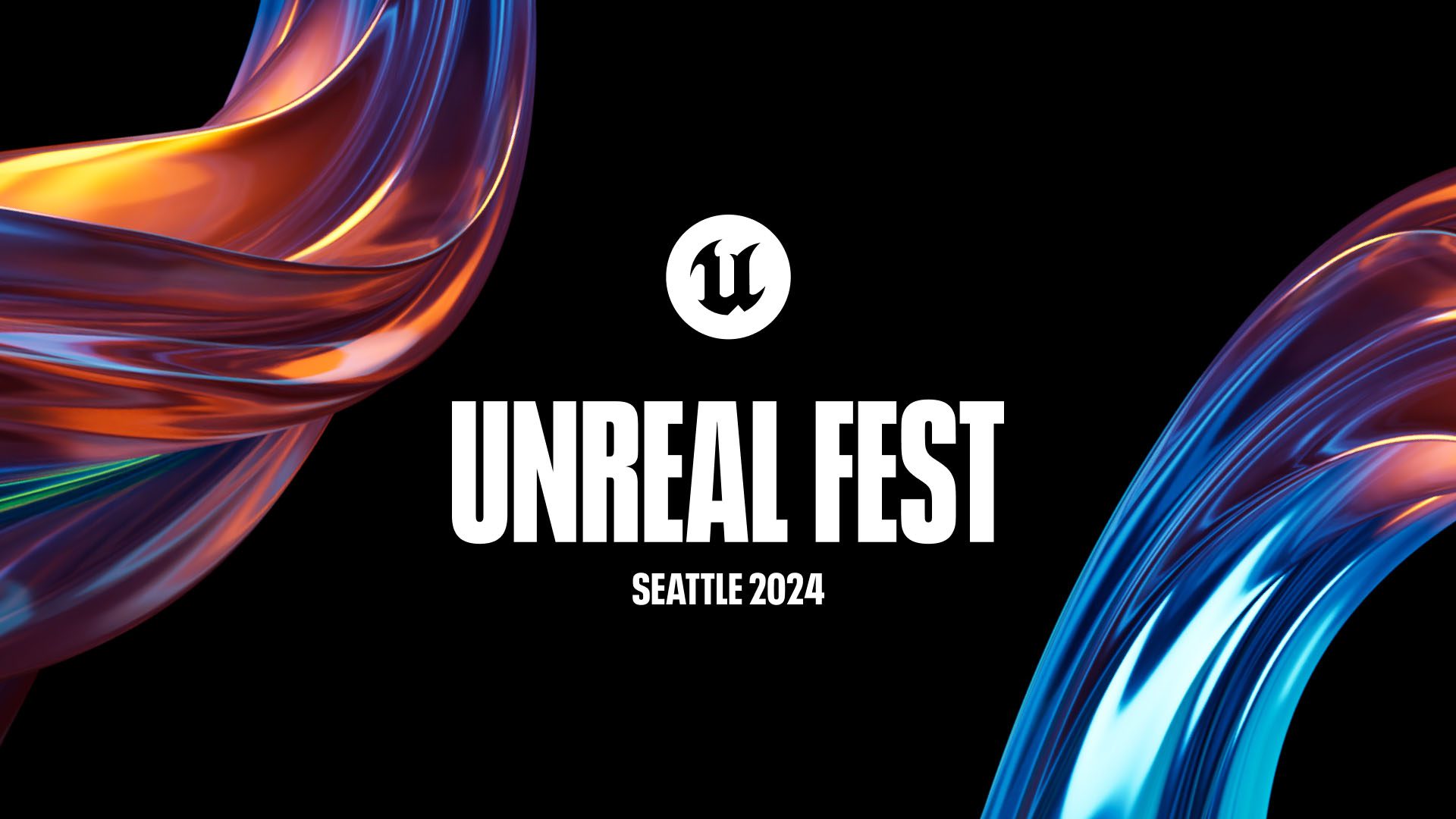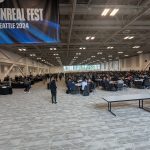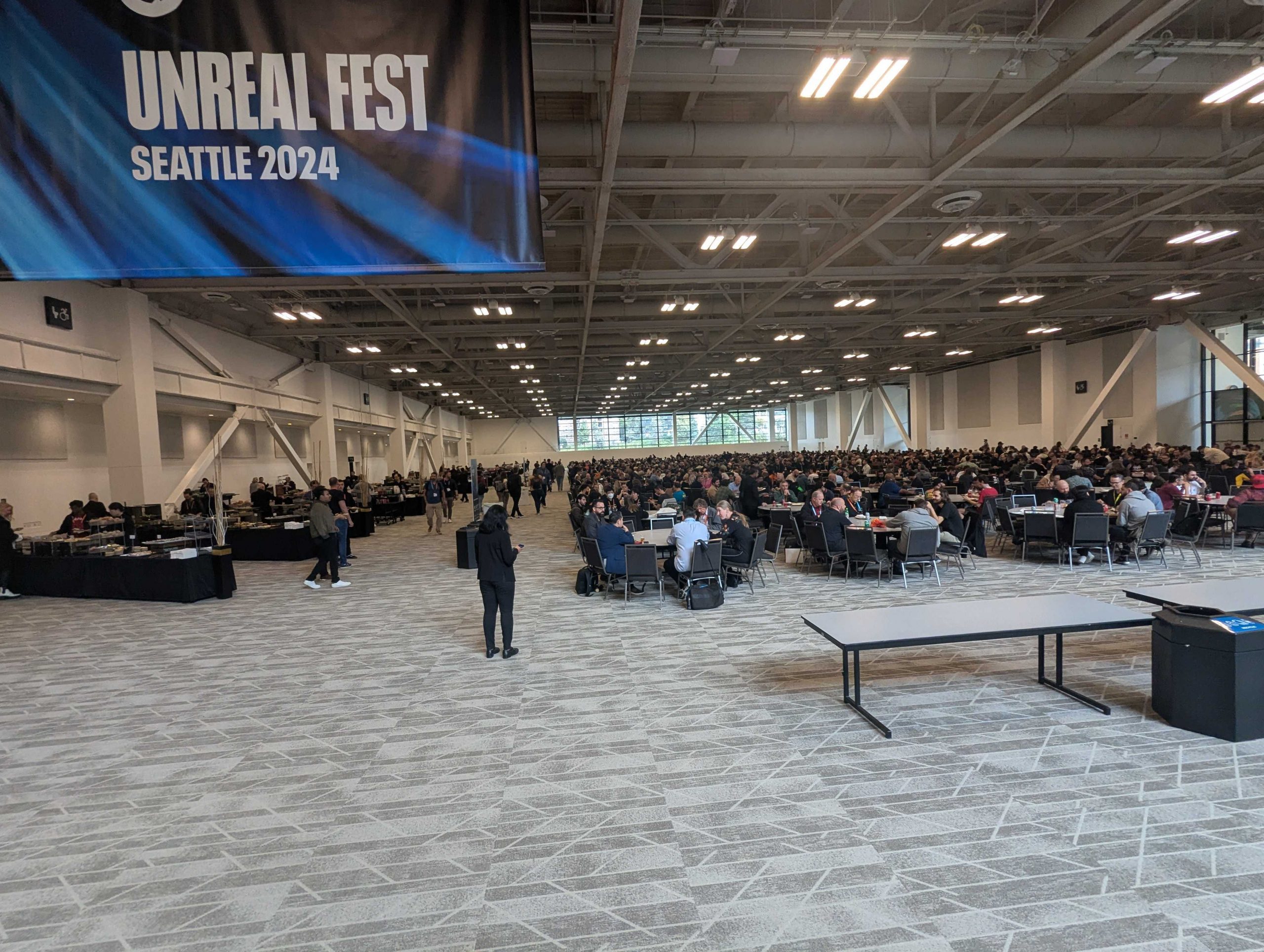Unreal Fest is one of the newer annual conferences hosted by Epic, dedicated entirely to Unreal Engine. Imagine Adobe MAX but focused exclusively on Unreal Engine—perhaps not quite as large, but with the same immersive energy. While Adobe MAX covers the extensive Adobe suite, Unreal Fest zeroes in on a single, powerful tool that’s redefining industries.
The conference began as a New Orleans event but has recently expanded to different locations worldwide, making it more accessible for attendees without the need for extensive travel. This year, the U.S. show took place in Seattle—my hometown—which offered me the perfect opportunity to experience the excitement and insights of Unreal Fest firsthand.

General impressions
I’ve attended numerous industry conferences and must say that Unreal Fest was exceptionally well organized. One of my pet peeves at conferences is when sessions don’t all start and end at the same time. For example, session one might run from 9 am to 10:30 am. Meanwhile, session two runs from 10 am to 11 am. Scheduling like this makes it difficult to plan which sessions you want to attend. Unreal Fest, on the other hand, had all sessions start and end at the same time. There are still so many great-looking sessions that you have to pick and choose what you want to attend, but at least you can base your choice on content versus time. Along with that, there is a scheduled 15-minute break between sessions. You might need to leave the first session early at many other conferencesto make it across the conference center in time for the next session. This also gave attendees plenty of time to stick around for questions or make a quick bathroom break.
Another great feature of the conference was that refreshments and snacks were readily available in the hallways outside the session rooms. Coffee, tea, and sodas were all out for anyone to grab as needed. They also had a variety of snacks, ranging from prepackaged granola bars to fresh fruit, freshly baked cookies, and even ice cream on one occasion. At other conferences, any food or beverages were limited to what the on-site vendors had, and prices were often inflated.
Speaking of food, both breakfast and lunch were provided every day. These meals were all high quality, with good options for vegetarians or those with other food sensitivities. All items were served buffet style, with allergen information prominently displayed for each dish. They also blocked out a little over an hour each day for lunch. All attendees would show up in the dining hall, grab food, and then mingle at the shared table. These were great opportunities for networking and sharing what everyone else has seen so far.
Specific Sessions
I attended numerous sessions during the event. Much like any other industry conference, some were great, while others lacked real substance. Outside studios put on a few sessions, and the description said the session would cover specific workflows, but then, in reality, it was little more than an ad for the studio. This is pretty typical of any show.
Of course, the big opening session was the keynote featuring Time Sweeny. Tim was absent from the GDC keynote unveiling 5.4 this year, so it was great to see him on stage again. Tim covered the future of Unreal and Epic, while others went over updates coming with Unreal 5.5. I cover some of my key takeaways in this article. Overall, the keynote was a great kickoff to the conference.
Virtual Production on AMD GPUs?
One session I found fascinating was titled “Advancing Virtual Production: Exploring the All-AMD Reference Architecture for In-Camera VFX Workflows.” While the title is a mouthful, the gist of it was a way to use AMD GPUs for running LED walls using 5.5’s new PTP to sync the systems instead of NVIDIA’s Quadro Sync card paired with NVIDIA’s professional GPUs. NVIDIA still dominates the performance aspect in Unreal Engine, especially if real-time ray tracing is involved, and it has been the only real option due to the need for Sync. The fact that AMD has a working option for LED walls is encouraging. More competition is always a good thing. AMD still has some hurdles to overcome, such as PTP not being as widely supported in other hardware like LED walls, cameras, and motion tracking hardware. But this is still early in development.
Building Worlds Faster
Another interesting session was “Geometry Scripting and Scriptable Tools.” This is a combination of Unreal’s Procedural Content Generation and Editor Utility Widgets. Users can create their own tools for populating the game world based on PCG rules using custom UI. One example given was populating lights in the world. The tool would choose a wall lamp if the mouse were pointing at a wall and a floor lamp if pointing at the floor. Another tool would allow the user to draw an area on the landscape and then fill that area with predefined assets based on preset rules. As games are getting larger, tools like this will make artists more efficient with their time.
Building Code Faster
The last session I want to mention was “Horde and the Unreal Build Accelerator.” Horde was first introduced in Beta with 5.4. Horde and UBA are a set of tools that include remote execution of C++ compilation, build automation system, test automation, analytics etc. Much of this is still in development, but any user who would consider implementing these sorts of tools probably has the knowledge to work around any issues that may arise. Games are getting bigger and more complex each year, so having tools that can help speed up that build process will be of great interest to developers. Many studios also have quite of bit of hardware that sits idle in the off hours, being able to utilize existing hardware could be a substantial cost savings.
Expo Hall
The only complaint I have is the Expo Hall. At most conferences, the Expo Hall is a great place to see tool developers, hardware vendors, or game developers showing off their work. However, at Unreal Fest, the Expo Hall was very sparse. Half of it was dedicated to demos of Epic’s own tools, such as MegaLights, FAB, Metahumans, etc. AWS had a large booth discussing their services, which ironically featured several games made with Unity. Other than that, there may be four or five folding tables with other vendors, but there is very little to show. This could be a great place to showcase developers who sell tools or assets on Epic’s FAB marketplace. They could also showcase LED wall manufacturers, motion capture hardware, etc. Unreal has become so big that entire supporting industries have popped up around it, an actual Expo Hall would be an excellent opportunity to highlight that.
Conclusion
Unreal Fest 2024 provided an invaluable look into Unreal Engine’s latest advancements and future directions. The conference was exceptionally well organized, with thoughtfully scheduled sessions, quality food and refreshments, and ample time for networking and knowledge sharing. Despite a somewhat sparse Expo Hall, the event as a whole was an impressive showcase of both Epic’s capabilities and the creativity of the Unreal community. Unreal Fest is a key gathering for professionals across industries, highlighting Unreal Engine’s expanding influence in gaming, virtual production, and beyond. I highly recommend that anyone working with Unreal attend at some point. The 2025 Unreal Fest will take place June 2nd – 5th in Orlando, Florida.










